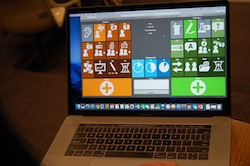How can I assess the level of student engagement in my class?

Instructors who are attempting active learning are often concerned that students won’t like it, or will resist. It can be hard, even in the middle of a course, to gauge how well-engaged students are. This article focuses on ways to assess student engagement, both formally and informally. For ideas on how to address problems in student engagement see the Expert Recommendation “How can I set clear expectations and motivate students so that they engage in active learning?”
Interested in more ideas on student engagement? You can see all my articles on helping students engage in active learning, and also download a PDF summary of all recommended engagement strategies.
Assessing students' perceptions of the course and instructor
One of the best ways to assess student perceptions and engagement is through a mid-semester evaluation. Some ways of doing a midterm assessment include:
- Stop Go Change 3-question survey to assess how things are going, or another informal survey. This is best done after ~2-3 weeks of class so you have time to make corrections.
- See if your teaching and learning center offers mid-course student assessments (details of how one institutions does this, guidance from EP3 on using student feedback forms for formative assessment).
- Hold a focus group with students (or ask a colleague to do this) to hear about how students would like to learn, and then share this information with the class as a whole.
Listening to your students, and addressing problems early can increase students’ sense of autonomy, and their trust in your good will (see my separate article on student engagement).
Below are several validated assessments you can also use:
- Classroom climate inventory. Measures student perceptions on the classroom climate and the atmosphere for learning.
- Instructor credibility scale. Measures student perceptions of instructor credibility (competence, goodwill, and trustworthiness).
- Facework scale. Students reflect upon instructors’ attending to facework (mitigating potential threats to a student’s image in social situations).
Assessing student engagement or resistance
- Student Response to Instructional Practices (StRIP). Survey which measures student response to instruction, and instructional strategies for influencing such engagement. (Information on development here).
- Classroom Observation Protocol of Student Resistance. A structured observation protocol to assess the level of student resistance in active learning classes.
- Behavioral Engagement Related to Instruction (BERI). A structured observation protocol to assess the level of on-task behavior in the classroom.
- Exposure-persuasion-identification-commitment (EPIC) survey. A classroom survey to assess the degree of engagement in class activities. See Supplemental Material of linked article.
Assessing student expectations about the course
- Maryland Physics Expectations Survey (MPEX). Probes aspects of students’ expectations in physics courses.
- Pedagogical Expectancy Violation Assessment (PEVA). An instrument to gauge the disconnect between student expectations and the actual course structure.
Assessing students’ learning attitudes and habits
There are several additional assessments of student attitudes towards learning on PhysPort’s Assessments Page.
- Colorado Learning Attitudes about Science Survey (CLASS). Measures students’ self-reported beliefs about physics and physics courses. Also developed for biology, chemistry, and experimental physics.
- Maryland Physics Expectations Survey (MPEX). Probes aspects of students’ expectations in physics courses.
- Epistemological Beliefs Assessment for Physical Science (EBAPS). Probes epistemological stances (beliefs about learning) of students in physics, chemistry, and physical science.
- Effective Learning Strategies Survey (ELSS). Assesses student habits and strategies that tend to promote learning.
- Motivated Strategies for Learning Questionnaire (MSLQ). A survey instrument describing self-regulated learning habits, such as the extent to which students are proactive contributors to the course.
Assessing student motivation and goals for learning
- Physics Goal Orientation Survey (PGOS). Assesses students’ motivation and goal orientation in university-level physics.
- Sources of Self-Efficacy in Science Courses – Physics (SOSESC-P). Assesses students’ beliefs that they can succeed in their physics courses.
- Colorado Learning Attitudes about Science Survey (CLASS). Measures students’ self-reported beliefs about physics and physics courses. Also developed for biology, chemistry, and experimental physics.
- Sense of Belonging to Math scale. Measures students’ sense of membership, acceptance, and trust in math.
This article is a product of the Framing the Interactive Engagement Classroom project, led by Stephanie Chasteen (University of Colorado Boulder), with collaboration from Jon Gaffney (Eastern Kentucky University) and Andrew Boudreaux (Western Washington University). Many thanks to University of Colorado reviewers Rebecca Ciancanelli and Jenny Knight, plus undergraduate assistant Maya Fohrman. This work was generously supported by the University of Colorado Science Education Initiative and the University of Colorado Center for STEM Learning, via a Chancellor’s Award. Please contact Stephanie Chasteen with any comments or questions.
Image courtesy of PhET Interactive Simulations, University of Colorado Boulder
 Add a Comment
Add a Comment


